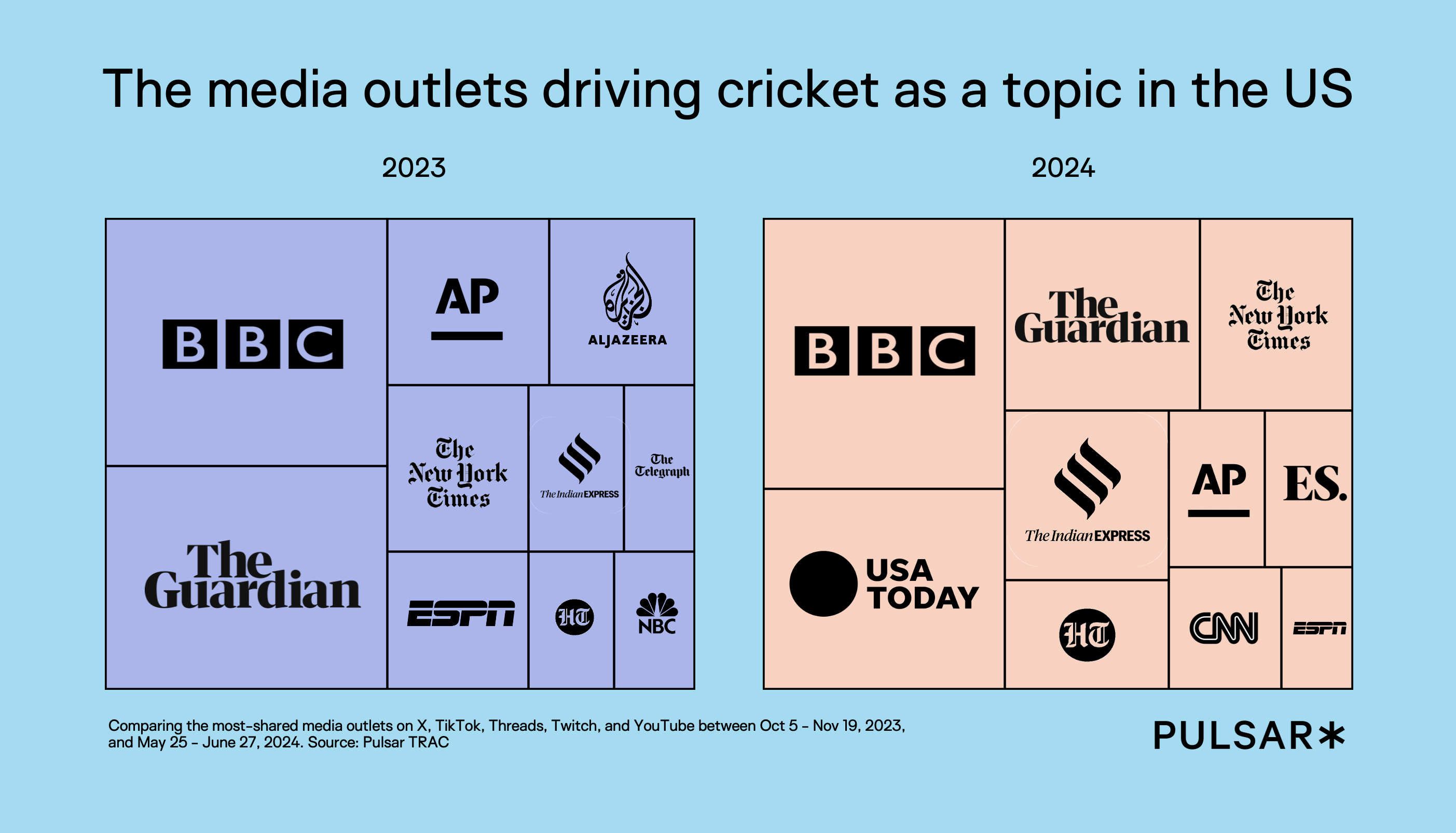
How successful has the 2024 cricket world cup been in reaching new, American audiences?
- Sport
The world’s first international game of cricket did not involve England, Australia or India, but rather the United States. Their opponents, Canada, won by 22 runs and the sport’s popularity in North America went on to dip below baseball following the Civil War. So when the International Cricket Council announced the joint hosts of the World Cup as the United States and the West Indies, it was ostensibly something of a homecoming for the sport.
Except, of course, international sporting councils rarely make multimillion dollar decisions based on historical sentiment. Exactly 170 years after that first match, the tournament’s organizers saw an opportunity to grow their sports commercial opportunities and cultural impact. And in order to make this a reality, they needed to identify a viable audience in the face of long-established skepticism.
Like I really enjoy cricket, a unique sport that I think people would enjoy here given the chance, but there's a lot of gatekeeping regarding new US fans too
— Nathan Tucker (@SportWatcherPRO) June 3, 2024
Using Pulsar TRAC, we explore the conversation taking place around cricket within the US across social platforms such as X and Threads, as well as media sources such as online news and television. We’ll benchmark the conversation around this most recent tournament against its 2023 predecessor, which took place in India, to investigate whether the US-hosting has helped to introduce the game to new audiences - and who those audiences are.
Audience interest within the US has clearly been larger than in 2023. Outside of the USA team achieving a shock victory over Pakistan, however, this has only sporadically gone beyond a 100% rise. A huge uplift in normal circumstances, but perhaps not commensurate with the notion advanced before the tournament, of massive untapped potential.
That Pakistan victory was highly significant, because it was the moment when the tournament achieved an element of mainstream crossover. Conversation was amplified by those outside the cricket fandom, whether celebrating stories that fused underdog spirit with high-achieving exceptionalism:
The U.S. just stunned Pakistan at the Men's T20 Cricket World Cup in one of the biggest upsets in the sport's history.
Saurabh Netravalkar is one of Team USA's top players, but his full-time job: Principle Engineer at Oracle. pic.twitter.com/DXNVzRGAzs
— Front Office Sports (@FOS) June 6, 2024
Or posts that reflected America’s amusement and pride, as their country excelled in a sport few followed or understood.
The world: “Hey America. Wanna try cricket?
Murica: “Sure. Just looks like a nerds version of baseball.”
World: “Uh. It’s the second most watched sport in the world you uncultured swine. We’re gonna crush these rednecks!”
Also world: “Hey America. Uh, yall won by 5 overs.”…
— Noel Olinde (@TheCajunLibert1) June 9, 2024
Following the team’s elimination at the hands of England, who merrily countered years of brand and audience-building with a flurry of sixes, interest levels appear to have reverted, and even close to almost exactly match the 2023 benchmark.
We can assume something of a hangover effect, as the same audiences who were drawn to the tournament by the US team's success experienced a sudden dip in interest following their elimination.
This underlines an inescapable truth in growing a sport - nothing is quite so effective as letting a fandom share in success. But brand building and education becomes essential in providing a platform for the momentary excitement to mature into a stronger, longer-standing fandom.
By that same token, we might equally ask why the 2023 baseline was already so high, in a competition the US did not play in - and which took place comfortably outside of US primetime slots.
The answer can be found within the sport's US audiences. Because, while comments painting cricket has a quintessentially English pastime reoccur in online conversation, they ignore that the game's gravitational centre as long since moved to South Asia.
And it is in South Asian diaspora that we find many of the US's more averred cricket fans.
In many senses, then, the sport's US growth is predicated on capturing and amplifying the interest of specific communities within a demographic.
Economic research places Americans of Asian heritage as the USA's highest-earning ethnic demographic, with Indian Americans a particulary high-earning subdivision. Almost 5 million Indian Americans live within the US, in addition to sizeable communities of Pakistani, Bangladeshi and Sri Lankan descent - the ICC have clearly recognised an opportunity to grow their global audience.
Clearly, not all South Asian Americans are cricket fans. But as our audience analysis indicates, a high percentage of active US cricket fans are South Asian American. We see a similar trend, although less accentuated, in the role of Hispanic communities in driving the growth of soccer in the US.
So what does a closer look at the US audiences tell us? By segmenting the audience according to their shared online affinities and behaviours, we can go beyond simple demographic data.
It reveals that 2023's conversation was predominately driven by US-based fans of India and Pakistan (in fact, so great was the Indian support that it can even be divided between more casual and diehard fans).
Fast-forward to 2024 and we see these core communities grow larger and more dominant. At the same time, however, we also see audiences whose presence suggest a mounting mainstream recognition. Sports Buffs - millennial fans of basketball and baseball - are joined by mainstream groups such as NYT readers and Democrats, a sure sign that Americans outside the traditional interest groups are showing an interest. The tone of this post, for instance, may trend towards arched boosterism, but the very fact of cricket's inclusion is telling:
Actually the American empire is alive and well and we got nothing but green lights ahead. Best economy, culture, basketball/baseball/hockey/football, increasingly competitive cricket and soccer teams, hottest chicks, most lethal fighter jets, natural gas coming out our eyeballs https://t.co/uiEFtZ5UL9
— Ben Dreyfuss (@bendreyfuss) June 24, 2024
Viewing the conversation through the spectrum of these communities places the conversational dip in context. Broadly speaking, we can divide the US audiences into three.
- Indian and Pakistan fans whose interest is directed primarily at subcontinental teams. These communities were present in both 2023 and 2024, and their participation in the conversation has not significantly dipped following the US exit.
- Conservatives and NYT readers. Both these communities engaged with the tournament when the US were performing well, either ironically or earnestly, but disappeared once they left the tournament.
- Perhaps the most interesting grouping of all - Democrats and Sports Buffs. Both these communities saw interest levels rise when the US were performing well, and decline on their defeat - but they remain at an elevated level to what they were pre-tournament.
Members of these latter communities potentially provide more scope for cricket in the US to grow beyond its traditional South-Asian base.
Just as important as identifying the audience of cricket in the US is identifying which media outlets play the greatest role in shaping conversation.

Cricket takes place across a broader geographic sweep than almost any other sport, with teams often more likely to fly halfway around the world rather than play a near neighbour. This further underlines the importance of media outlets is communicating information and channelling narratives to established and emerging fanbases.
The most immediate observation is the outsized influence of both British and Indian publications. 2024 saw a slight redress of this, with USA Today taking second-spot as the most shared website amongst US cricket fans. Even here, however, the articles mostly concentrated on the novelty and potential cultural importance of the WC, rather than the type of locally-sourced game analysis seen in other sports.
This would appear to signify opportunity for media brands, whether that equates to British or Indian publications writing for US audiences, or US publications building out bespoke Cricket content streams. The travails of current journalists, however, suggest that the recurrent interest and infrastructure that could evolve this 'potential' into bona fide media opportunities is not currently in place.
And that epitomizes much in the nature of US cricket fandom. Strengthening the fandom of South Asian American communities, and giving them more opportunities to express their fandom stateside, is likely to remain the centrepiece of any strategic approach. Supplementing this fandom with additional US sports fan commuities will help to strengthen interest and create a larger, more consistently active audience.
It may yet be some time before mainstream US audiences are familiar with silly mid-on, cow corner or the Duckworth-Lewis method - but if the rain can stay away, there are indications cricket could yet enjoy a long innings in the US.


